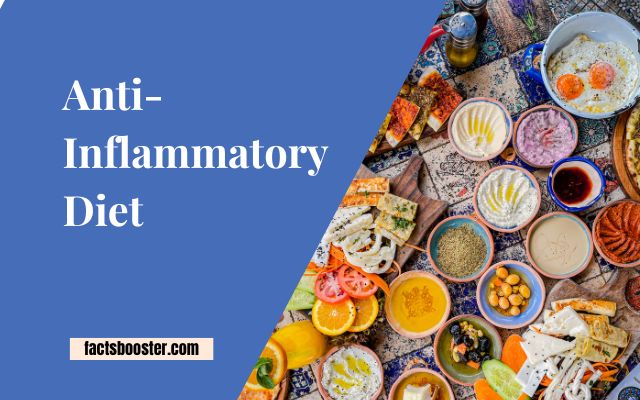Embarking on an Anti-Inflammatory Diet is akin to setting sail towards better health. This dietary journey is not just about what you eat; it’s about nurturing your body’s natural defenses against diseases.
By prioritizing anti-inflammatory foods, you’re essentially fortifying your immune system to effectively fight inflammation, a notorious contributor to a myriad of chronic conditions.
This diet underscores the power of nutrition in maintaining well-being and showcases how the right foods can be both a shield and a weapon against health adversities.
Key Takeaways:
- Anti-Inflammatory Diet: A health-centric eating plan focusing on foods that support the immune system and combat inflammation.
- Immune System Support: Highlights the diet’s role in bolstering the body’s natural defenses.
- Fight Inflammation: Underlines the importance of choosing foods that help reduce inflammation for overall health benefits.

Foods That Cause Inflammation
Many of us unknowingly fuel our bodies with foods that exacerbate inflammation, directly impacting our immune system’s effectiveness. Foods high in sugar and saturated fats are notorious for their inflammatory effects.
But it’s not just the sweet and fatty foods; refined carbohydrates, like those found in white bread and pastries, along with processed meats, can silently contribute to inflammation, putting our health at risk. Additionally, certain vegetable oils used in cooking can promote inflammation due to their high omega-6 fatty acid content.
As you consider your dietary choices, think about not just the pleasure foods bring to your palate but also how they affect your body’s inflammatory response and, ultimately, your immune system’s ability to fight inflammation.
Read more:
The Inflammatory Risks
Embarking on an anti-inflammatory diet isn’t just about adding delicious anti-inflammatory foods to your plate; it’s also about understanding the risks of ignoring the fight against inflammation.
Chronic inflammation, often fueled by a diet high in foods that cause inflammation, can silently but steadily wear down your immune system, leaving the door ajar for a myriad of health issues. This silent assailant can contribute to heart disease, stroke, and even diabetes.
The health risks associated with inflammatory foods are significant, and adopting an anti-inflammatory diet can be a powerful shield. It’s not just about cutting out the bad; it’s about embracing foods that support your immune system in its relentless fight against inflammation.
By understanding these risks, you’re taking the first step towards safeguarding your health and well-being.
Anti-Inflammatory Diet – The Anti-Inflammatory Foods
Delving into the realm of anti-inflammatory foods is akin to discovering a treasure trove of health-enhancing gems. Not only do these foods fight inflammation, but they also offer a robust boost to the immune system, safeguarding your well-being from the inside out.
At the forefront of this nutritional powerhouse is the humble berry – blueberries, strawberries, and raspberries, each bursting with antioxidants that combat inflammation and shield your health.
Omega-3-rich salmon emerges as a champion of the cause, offering not just anti-inflammatory benefits but also heart health support. Don’t overlook the power of leafy greens like spinach and kale; these verdant allies are loaded with vitamins and flavonoids that play a critical role in reducing inflammation.
Incorporating these champions into your diet isn’t merely a dietary choice—it’s a stride towards invigorating your body’s defenses and nurturing your health with every bite.
The Power on Your Plate
Adopting an Anti-inflammatory Diet is more than just a meal plan; it’s a gateway to a healthier life. This diet, rich in anti-inflammatory foods, plays a pivotal role in boosting our immune system and equipping our body to fight inflammation more effectively.
Evidence from numerous studies suggests that incorporating foods known for their anti-inflammatory properties can dramatically reduce the risks associated with chronic diseases such as heart disease, diabetes, and arthritis.
Moreover, this diet promotes overall well-being, enhancing energy levels, improving mood, and contributing to weight maintenance. By shifting our focus to what’s on our plate, we possess the power to influence our health positively.
This strategic approach to eating not only combats inflammation but also fortifies our body’s defense system, facilitating a more vibrant and disease-resistant life.
Cooking Methods Matter
How you cook your food can be just as crucial as the ingredients you select. The wrong cooking methods have the potential to significantly enhance the inflammatory nature of your meal, counteracting the benefits you’re aiming for with anti-inflammatory food.
It’s like taking two steps forward with your healthy choices and then unfortunately two steps back with the way you’re preparing them.
But fear not, transforming your kitchen habits is simpler than you might think. For starters, steering clear of deep-frying and choosing to bake, steam, or grill can make a huge difference.
These methods help preserve the integrity and anti-inflammatory properties of your food. For example, grilling vegetables with a dash of olive oil not only keeps the nutrients intact but also adds a delicious smoky flavour without the added stress on your immune system.
Similarly, steaming fish retains its omega-3 fatty acids, a champion fighter against inflammation.
By shifting your focus to these healthier cooking practices, you’re not just fighting inflammation with the ingredients you choose but also with how you bring your meals to life. It’s a comprehensive approach to ensuring your diet supports your immune system and overall well-being.
How to Reduce The Risk of taking Processed Food
Scrutinizing the labels on processed food is crucial. It’s essential not only for fighting inflammation but also for boosting your immune system. You see, ingredients like high fructose corn syrup, trans fats, and artificial additives can secretly fuel inflammation.
So, how do you sidestep these hidden hazards? Start by becoming a label detective. Look beyond catchy marketing slogans and zero in on the actual ingredients list. The longer and more chemically complex it is, the more likely the product is to provoke inflammation.
Moreover, don’t be fooled by claims of being “natural” or “healthy” without evidence. Instead, steer towards whole, unprocessed foods. Fresh fruits, vegetables, lean proteins, and healthy fats are the champions of an Anti-inflammatory Diet.
These foods naturally contain anti-inflammatory properties, helping not only to fight inflammation but also to support and enhance your immune system’s functionality.
By making simple swaps – such as choosing whole grains over refined ones and selecting fresh produce over canned or packaged alternatives – you can significantly reduce your intake of inflammatory processed foods.
Actionable Steps to Adopt an Anti-Inflammatory Diet
- Start with Small Substitutions: Begin by swapping out foods known to cause inflammation, like processed snacks, with anti-inflammatory alternatives such as nuts or berries. An easy switch can make a big difference.
- Incorporate More Greens: Make it a goal to fill half your plate with vegetables at every meal. Leafy greens, in particular, are packed with anti-inflammatory properties that can bolster your immune system.
- Choose Your Fats Wisely: Replace saturated fats found in red meats with healthier options like avocados, olive oil, and fatty fish. These contain omega-3 fatty acids, key players in the fight against inflammation.
- Spice It Up: Don’t underestimate the power of spices. Turmeric, ginger, and cinnamon are not just flavor enhancers – they’re also potent anti-inflammatory agents.
- Plan Your Meals: Taking the time to plan your meals for the week can help you avoid the temptation of fast food, ensuring you stick to your anti-inflammatory diet goals.
- Stay Hydrated: Adequate water intake is crucial for flushing out toxins that can contribute to inflammation. Aim for eight glasses a day to support your immune system.
Bottom Line
As we’ve navigated through the ins and outs of the Anti-Inflammatory Diet, it’s evident that the power to fight inflammation and bolster our immune system lies substantially in our hands.
Embracing anti-inflammatory foods is not just about what we eat; it’s a holistic approach to nurturing our well-being. By recognizing and mitigating the risks of inflammatory foods and adopting cooking methods that preserve the richness of anti-inflammatory nutrients, we empower ourselves towards a healthful transformation.
Let this journey towards an anti-inflammatory lifestyle be a conscious choice for vibrant health and vitality, encouraging us to make choices that echo positively within our bodies and beyond. Dive into this inviting world where every meal can be a step towards a rejuvenated, healthier you.
Reference:
1. Alexander Scheiber, Victoria Mank, 2024 Jan, “Anti-Inflammatory Diets” (1)
2. PubMed Central, 2021 Aug, “Anti-Inflammatory Properties of Diet: Role in Healthy Aging” (2)
3. PubMed Central, 2018 Jan 23, “Inflammatory responses and inflammation-associated diseases in organs” (3)


